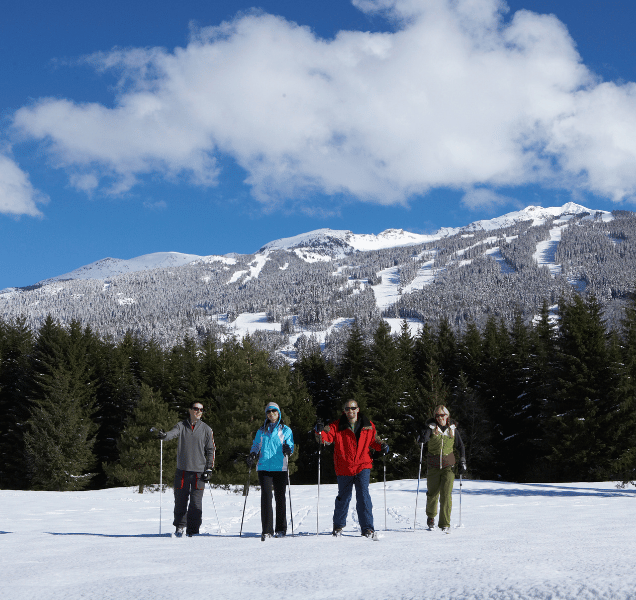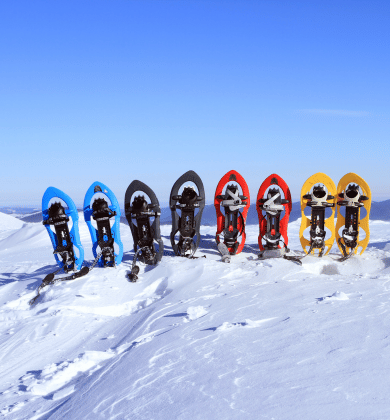
Snowshoeing in Canada
A Winter Adventure Awaits
Key Highlights
-
Discover the top snowshoeing trails across Canada’s stunning winter wonderland, from the Canadian Rockies to peaceful provincial parks.
-
Learn how to get started with essential gear tips, including information on basic techniques.
-
Explore the best places to snowshoe in Ontario and famous national parks like Banff, and Jasper.
-
Get practical advice on planning your trip, from finding trail maps to booking accommodations.

Snowshoeing can be a family affair
How to Get Started with Snowshoeing in Canada
Getting started with snowshoeing is easier than you might think! If you can walk, you can snowshoe, making it one of the most accessible outdoor adventures available. It’s a fantastic form of winter hiking that doesn't require the technical skills of skiing, allowing you to focus on the incredible surroundings.
Canada is a great place to try snowshoeing for the first time, with countless trails suitable for all levels. To begin your journey, you'll need the right gear and a basic understanding of a few simple techniques.
Essential Gear and Equipment for Beginners
Your comfort and safety while winter hiking depend on having the right gear. Dressing in layers is the most important rule. This allows you to add or remove clothing to regulate your body temperature as you warm up from the exercise or cool down during breaks. A waterproof outer layer is also essential to stay dry.
For beginners, considering snowshoe rentals is a smart first step. Many outdoor shops near popular parks offer rentals, allowing you to try out the sport without a big investment. They can also help you choose the right size and type of snowshoe for the trails you plan to explore.
Beyond snowshoes, here are a few other essentials to pack:
-
A warm hat and spare mitts
-
Hand warmers for extra cold days
-
Microspikes for icy sections where snowshoes aren't needed
-
For backcountry trails, avalanche safety gear and the knowledge to use it are non-negotiable.

Learning Basic Snowshoeing Techniques
Once you have your gear, it's time to hit the snowshoe trail. The fundamental technique is simple: walk with your feet slightly wider apart than usual to avoid stepping on your snowshoes. Start on a flat, well-packed trail to get a feel for the movement.
As you become more comfortable, you can try different terrains. Different skill levels will determine the type of trail you choose for your winter hike. For beginners, it's best to stick to marked trails with gentle slopes.
Here are a few basic techniques to practice:
-
Walking Uphill: Use your toe crampons (the teeth under the front of your snowshoes) to dig into the snow for traction.
-
Walking Downhill: Keep your knees bent and body weight slightly back, letting the heel crampons provide stability.
-
Traversing a Slope: Dig the uphill edge of your snowshoes into the hillside to create a stable platform with each step.
What are the Top Snowshoeing Regions in Canada?
The Canadian Rockies, particularly in Alberta and British Columbia, are a major draw for their dramatic scenery and extensive trail networks. However, you can find incredible snowshoeing opportunities in other provinces as well. Let's explore some of the top regions to strap on your snowshoes.
Must-Visit Snowshoeing Trails in Alberta
Alberta is arguably the heart of snowshoeing in Canada, thanks to its magnificent mountain parks. You don’t have to go far to find deep snow and some of the best trails in the country. The province is packed with routes that deliver great views without extreme difficulty.
From the world-renowned national parks to the accessible Kananaskis Country, Alberta offers a lifetime of snowshoeing adventures. Here are a few must-visit areas that showcase the best of what the province has to offer.

There's nothing like returning to a warm RV after a day of snowshoeing
Banff National Park: Iconic Routes and Scenic Views
Banff National Park is a top destination for a reason. The scenery is simply unparalleled. A classic snowshoe route is the trail beside Lake Louise. The flat, easy path along the shoreline provides iconic great views of the Victoria Glacier, making it perfect for beginners and families.
For a bit more of a workout, the trail to Mirror Lake and Lake Agnes offers a steady climb with first-class mountain views along the way. While the trail becomes more challenging with avalanche risk past Mirror Lake, the journey to that point is a fantastic and popular outing in Banff National.
Another excellent choice is the 12 km return trip to the Ink Pots. This trail takes you through a pretty, snow-dusted forest to a series of unique, crystal-clear mineral springs. The mix of forest scenery and open meadows with mountain backdrops makes it a memorable adventure.
Kananaskis Country and Popular Locales
nd for good reason. After an initial steep section, the trail opens into meadows with stupendous mountain views all the way to the frozen lake.
Another fantastic destination is Rawson Lake. The trail starts at the scenic Upper Kananaskis Lake and climbs through the forest to the stunning, mountain-ringed lake. It's a 7.8 km round trip that feels like a true mountain adventure but is manageable for many fitness levels.
For those seeking great views of the Spray Lakes Reservoir, the trail to Rummel Lake is an outstanding choice. Although it’s less marked than other trails, the climb up old logging roads offers incredible scenery. It’s a quieter alternative to some of the more popular Kananaskis Lake area trails.
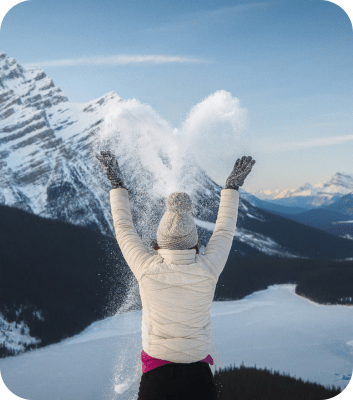
Jasper National Park: Pyramid Lake and Nearby Trails
The area around Pyramid Lake is one of Jasper's most scenic and accessible snowshoeing spots. The Pyramid Overlook hiking trail is a well-traveled route that offers a moderate climb to a stunning viewpoint. From the top, you are rewarded with an incredible panoramic view of Pyramid Mountain perfectly reflected in the frozen lake below.
This trail provides some of the best great scenery for relatively little effort, making it a favorite for visitors and locals alike. The path is often packed down, making it an easy winter hike, but snowshoes are ideal after a fresh snowfall.
After enjoying the overlook, you can explore other trails around Pyramid Lake itself. The flat terrain around the lake is perfect for a leisurely snowshoe, allowing you to soak in the majestic winter landscape from different angles. It’s a postcard-perfect Jasper experience.
Jasper National Park: Valley of the Five Lakes and Medicine Lake Area
For a short and beautiful outing, the Valley of the Five Lakes trail is a fantastic choice. This 4.6 km loop takes you past a series of small, stunning lakes. In winter, the trail is quiet and serene, and the snow-covered landscape is particularly beautiful on a sunny day. It’s a great option for families or those looking for a quick dose of nature.
Further down the Maligne Lake Road, the Medicine Lake area offers more popular snowshoeing opportunities. After a big storm, you can find deep snow here, perfect for breaking trail. A hidden gem in this area is the guided tour to Watchtower Canyon, an easy climb up a narrow, frozen canyon that gets prettier the further you go.
Whether you choose the gentle loop of the Valley of the Five Lakes or the more adventurous exploration around Medicine Lake, both areas showcase the diverse and beautiful winter terrain that Jasper has to offer.
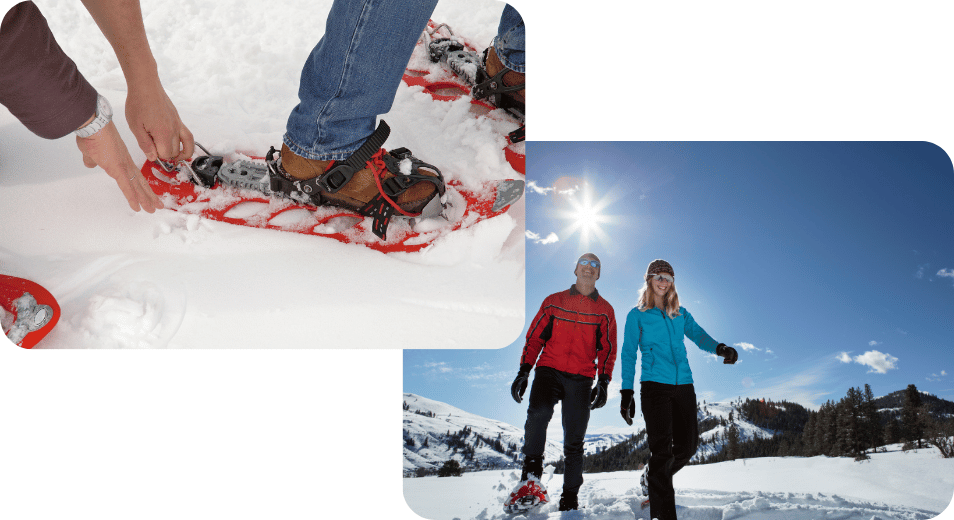
Alberta's National Parks are ideal for showshoeing
Exploring Ontario’s Best Snowshoeing Destinations
You don't need towering mountains to have an incredible snowshoeing experience. Ontario offers a different kind of winter beauty, with peaceful forests, dramatic escarpments, and frozen lakesides. The province's network of Ontario Parks provides a great place for winter adventures, with many offering dedicated and groomed snowshoe trails.
From the iconic Bruce Trail to the vast wilderness of Algonquin, there are countless opportunities to strap on your snowshoes and explore. Let's look at some of the best places to discover Ontario's quieter, yet equally magical, winter landscapes.
Algonquin Park: Winter Wonderland Trails
Algonquin Provincial Park transforms into a true winter wonderland once the snow falls. This vast park offers a remote and wild snowshoeing experience, with trails that take you deep into its iconic landscape of maple hills, rocky ridges, and thousands of frozen lakes.
The great scenery here is more intimate than in the Rockies. You’ll trek through silent, snow-laden forests of pine and spruce, with the chance to spot moose or hear the call of a winter bird. The solitude and pristine nature of Algonquin in winter are what make it so special.
Several of the park's hiking trails remain accessible in winter for snowshoeing, offering varying lengths and difficulties. Whether you choose a short loop or a longer, more challenging route, Algonquin Provincial Park provides an authentic Canadian winter experience far from any crowds.
Hidden Gems Near Toronto and Southern Ontario
You don't have to travel far from the city to find excellent snowshoeing. Southern Ontario is full of hidden gems, especially along the Niagara Escarpment. This UNESCO World Biosphere Reserve features dramatic cliffs, frozen waterfalls, and deep forests, offering surprisingly rugged terrain close to urban centers.
The famous Bruce Trail, which follows the escarpment, is a fantastic option for snowshoers. In winter, sections of the trail become quiet corridors through a snowy world, providing a perfect escape into nature. The trail offers endless possibilities for out-and-back trips of any length.
Other great spots can be found along the shores of the Great Lakes. For instance, parks along Lake Huron feature beautiful trails that wind through snow-covered dunes and forests with views of the frozen lake. These areas provide a unique coastal feel to your winter adventure.
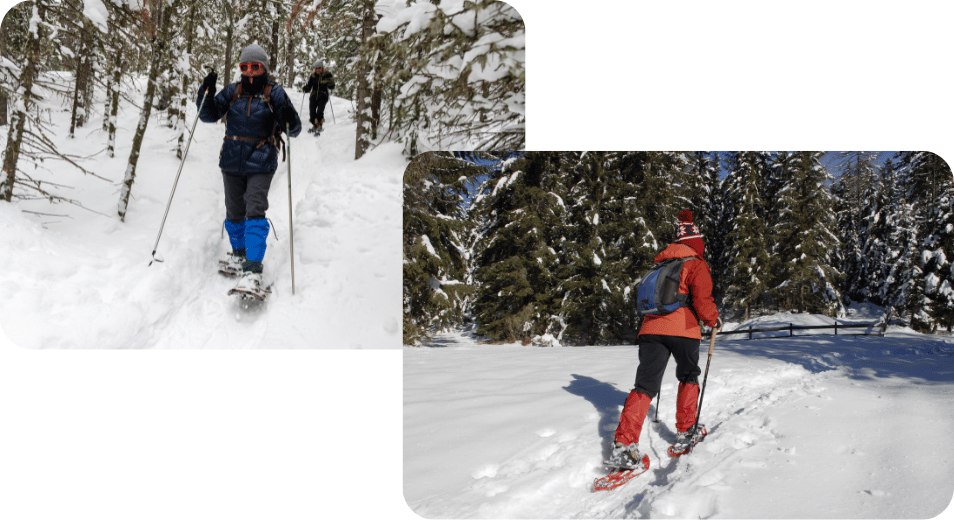
Snowshoe trails can be found across Canada
Tips and Resources for Planning Your Canadian Snowshoeing Adventure
Proper planning is the best way to ensure your snowshoeing adventure is safe and enjoyable. Before you hit the trails, taking the time to gather information can make all the difference. From trail conditions to accommodation, a little preparation goes a long way.
One of the most valuable resources you can use is local knowledge. Visiting local information centers, consulting park websites, and looking at recommended books or online guides will provide you with the most current and reliable details for your trip.
Booking Accommodations and Accessing Trail Maps
Snowshoeing and winter RVing go hand in hand. There's nothing like having your home on wheels with you when you return from a brisk winter adventure. CanaDream has a winter-ready RV built especially for winter adventures. Some National park campgrounds in Banff and Jasper stay open year-round offering powered sites and potable water. Many provincial parks in Ontario are also open for camping in the Winter. CanaDream's winter RVs allow you to have full use of water in temperatures as low as -30C making it an ideal way to move your 'home' with you as you visit different showshoe locations.
Finding reliable trail maps is essential for a safe trip. You can often download them from park websites before you go, but it’s always a good idea to have a physical copy as well. Many trailheads have a large map posted in the parking lot.
Here are a few tips for managing your routes:
-
Snap a photo of the trail map at the parking lot with your phone for a quick reference.
-
Pick up physical trail maps at a visitor center.
-
Use a GPS device or a GPS-enabled watch for backcountry or poorly marked trails to find the perfect place to explore safely.
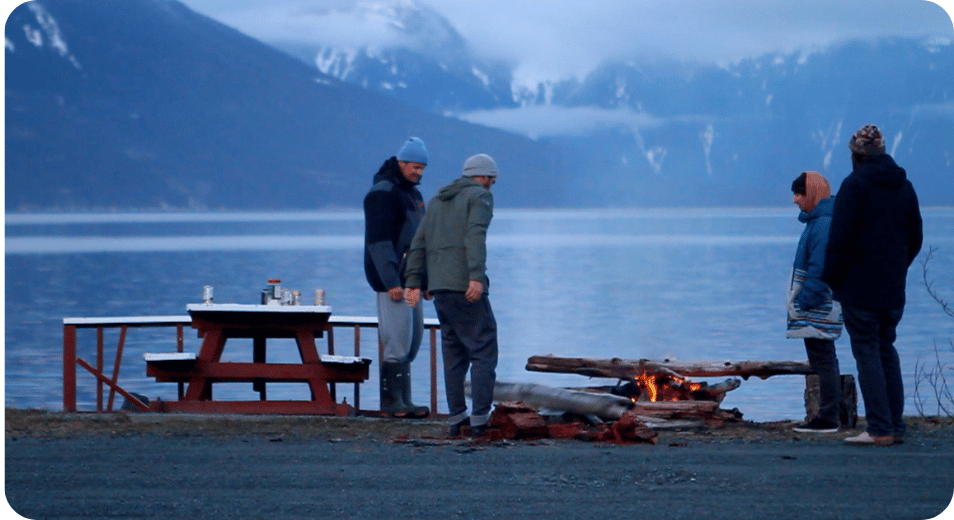
At the end of each day, nothing can beat a campfire
Conclusion
Snowshoeing in Canada offers an incredible winter adventure that connects you with the stunning landscapes and serene beauty of nature. Whether you're traversing the iconic trails of Banff and Jasper or discovering hidden gems in Ontario, every step on the snow brings a new experience. Remember to equip yourself with the right gear and knowledge to ensure a safe and enjoyable outing. With proper planning and awareness of trail etiquette, you can fully immerse yourself in the tranquility of the snowy wilderness. So, bundle up, lace up those snowshoes, and embark on your next adventure! If you're ready to explore, book your CanaDream winter-ready RV today to make the most of your journey in the Canadian winter wonderland.
Frequently Asked Questions
What should I wear while snowshoeing in Canada?
Dress in moisture-wicking layers: a base layer, a fleece mid-layer, and a waterproof/windproof outer shell. Wear insulated, waterproof winter boots, a warm hat, and gloves or mitts. Always pack extra layers, as conditions can change quickly from the parking lot to the trail.
Can I rent snowshoeing equipment at major Canadian parks?
Yes, snowshoe rentals are widely available in towns near major national parks like Banff and Jasper. Many ski resorts and some park-run trail centre locations also offer rentals. This is a great, affordable option for trying winter hiking without buying your own gear first.
Are there beginner-friendly snowshoeing trails for families?
Absolutely! Both national and provincial parks offer numerous easy, well-marked snowshoe trail options perfect for all skill levels, including families with children. Look for shorter, flatter loops around frozen lakes or through meadows, which provide a magical winter wonderland experience without a strenuous climb.

